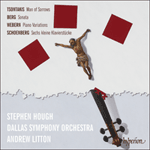
Welcome to Hyperion Records, a British classical label devoted to presenting high-quality recordings of music of all styles and from all periods from the twelfth century to the twenty-first.
Hyperion offers both CDs, and downloads in a number of formats. The site is also available in several languages.
Please use the dropdown buttons to set your preferred options, or use the checkbox to accept the defaults.

| Sir Stephen Hough (piano)» More |
The young Berg, still in his early twenties, presented the movement to Schoenberg as part of a longer projected composition, but was encouraged by his teacher to let the piece stand on its own. Beginning and ending in enigmatic quiet, the brief sonata manages to surmount turmoil and crisis in little more than ten minutes. As in Tsontakis’s Man of Sorrows, we return to the start but find that it is not the same.
from notes by Grant Hiroshima © 2007
À un peu plus de vingt ans, le jeune Berg présenta le mouvement à Schoenberg, en précisant qu’il faisait partie d’un projet plus ambitieux, mais le maître l’encouragea à le laisser tel quel. Ouverte et close sur une quiétude énigmatique, la brève sonate parvient à surmonter le trouble et la crise en un peu plus de dix minutes. Comme dans Man of Sorrows de Tsontakis, on revient au début, mais pour découvrir que ce n’est pas la même chose.
extrait des notes rédigées par Grant Hiroshima © 2007
Français: Hypérion
Der junge Berg, immer noch Anfang Zwanzig, gab Schönberg den Satz als Teil einer geplanten längeren Komposition, aber sein Lehrer ermutigte ihn, das Stück für sich stehen zu lassen. Die knappe Sonate beginnt und endet in rätselhafter Stille und schafft es, Aufruhr und Krise in kaum mehr als zehn Minuten abzuhandeln. Wie in Tsontakis’ Man of Sorrows kehren wir zum Anfang zurück, um herauszufinden, dass es nicht das Gleiche ist.
aus dem Begleittext von Grant Hiroshima © 2007
Deutsch: Renate Wendel
 Tsontakis: Man of Sorrows; Berg: Piano Sonata; Webern: Variations Tsontakis: Man of Sorrows; Berg: Piano Sonata; Webern: Variations‘A five-star performance and recording’ (Gramophone) ‘Brilliantly written for the keyboard and scintillatingly orchestrated … [Man of Sorrows] is superly played and recorded, patently sincere ...» More |

